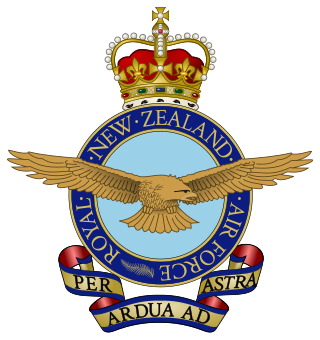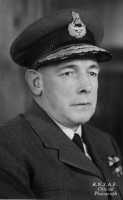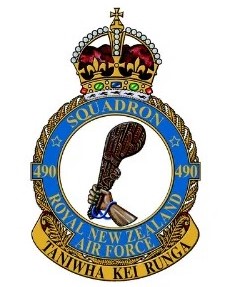The New Zealand Defence Force is the three-branched military of New Zealand. The NZDF is responsible for the protection of the national security of New Zealand and her realm, promoting its interests, safeguarding peace and security, as well as supporting peacekeeping and humanitarian missions. It consists of three services: the Royal New Zealand Navy (RNZN), the New Zealand Army and the Royal New Zealand Air Force (RNZAF), as well as tri-service components. As of June 2023, the NZDF has a strength of 14,996 employees, consisting of 8,669 regular force personnel, 3,260 reserve force personnel and 3,067 civilian members. It is supported by the New Zealand Ministry of Defence (MOD) and is commanded by the Chief of Defence Force (CDF).

The Royal New Zealand Air Force is the aerial service branch of the New Zealand Defence Force. It was formed initially in 1923 as a branch of the New Zealand Army, being known as the New Zealand Permanent Air Force, becoming an independent air force on 1 April 1937.

The New Zealand Air Training Corps is one of the three corps in the New Zealand Cadet Forces (NZCF), alongside the New Zealand Sea Cadet Corps and the New Zealand Cadet Corps. It is funded in partnership between the Royal New Zealand Air Force (RNZAF) and local communities. Members are civilians with no obligation to enlist in the New Zealand Defence Force (NZDF). Should a cadet enlist, their service in the ATC cadet does not translate into higher pay, rank, or seniority.
No. 75 Squadron was a unit of the Royal Flying Corps and Royal Air Force in World War I and the RAF in World War II. In 1940–1945, it was a bomber unit composed mainly of New Zealand-born personnel. In October 1945, the squadron number – along with its heraldry and honours – was relinquished by the RAF and transferred to the Royal New Zealand Air Force, officially becoming No. 75 Squadron RNZAF. No other RAF squadron has been gifted in this way, to another Commonwealth air force.

RNZAF Base Auckland is a Royal New Zealand Air Force base located near the upper reaches of the Waitematā Harbour in Auckland, New Zealand. The base formerly comprised two separate airfields, Whenuapai and RNZAF Station Hobsonville. Hobsonville was established as a seaplane station in 1928 and was the RNZAF's primary flying boat base in New Zealand until 1967.

No. 488 Squadron was the name given to two distinct Royal New Zealand Air Force squadrons during the Second World War. Both were formed under Article XV of the Empire Air Training Scheme and served under the operational command of the Royal Air Force.

Air Vice Marshal Sir Leonard Monk Isitt was a New Zealand military aviator and senior air force commander. In 1943 he became the first New Zealander to serve as the Chief of the Air Staff of the Royal New Zealand Air Force, a post he held until 1946. At the close of World War II, Isitt was the New Zealand signatory to the Japanese Instrument of Surrender. After the war, following retirement from the Air Force, he worked as chairman of Tasman Empire Airways.

No. 490 (NZ) Squadron was an anti-submarine and maritime reconnaissance squadron of Coastal Command established for service during the Second World War. It was a New Zealand squadron formed under Article XV of the Empire Air Training Plan. Although many of its flying personnel were drawn from the Royal New Zealand Air Force, the squadron served under the operational and administrative command of the Royal Air Force.

Norfolk Island Airport, is the only airport on Norfolk Island, an external territory of Australia. The island is located in the Pacific Ocean between Australia, New Zealand, and New Caledonia. The airport is operated by the Norfolk Island Regional Council, and is on the west side of the island.

Woodbourne Airport trading as Marlborough Airport is a small, controlled airport located 8 km west of Blenheim in the Marlborough region of New Zealand, on State Highway 6, Middle Renwick Road. It is co-located with RNZAF Base Woodbourne in the Wairau Valley on the north-eastern corner of the South Island of New Zealand. The airport has a single terminal and seven tarmac gates.
No. 189 Squadron was a Royal Air Force squadron.

The de Havilland DH.94 Moth Minor was a 1930s British two-seat tourer/trainer aircraft built by de Havilland at Hatfield Aerodrome, England. With the start of the second world war production of the Moth Minor was moved to de Havilland Australia at Bankstown Aerodrome, Australia.

Mangere Aerodrome, named after a nearby suburb, was the original home of the Auckland Aero Club. It is now the site of Auckland Airport. Mangere Aerodrome's claim to fame was as the arrival point for New Zealand aviator, and aeroclub member, Jean Batten's solo flight from the United Kingdom in 1936. The RNZAF requisitioned the aerodrome from 1939 until 1944, renaming it RNZAF Station Mangere. In 1961, the Auckland Aero Club moved to Ardmore aerodrome and Mangere Aerodrome closed. The new Auckland Airport opened in 1965.

The Royal New Zealand Air Force (RNZAF) is organised into a small number of flying squadrons and ground-based units. Most of the RNZAF's operational and training units are stationed at RNZAF Base Auckland and RNZAF Base Ohakea in the North Island. Several training and maintenance units are located at RNZAF Base Woodbourne in the South Island.

The history of aviation in New Zealand began in the late 19th century when balloon flights began. In the first decade of the 20th century, several New Zealanders began developing heavier-than-air craft. The first confirmed powered flight in New Zealand being made by Richard Pearse in 1902 though is considered uncontrolled.

The Territorial Air Force, or TAF, is a reserve air force that operates in New Zealand. The service traces its lineage back to a 1919 report that proposed an air force for the country manned by part-time volunteers, with the first recruits arriving in 1923. However, it was not until 1930 that the Territorial Air Force was formally constituted. The pilots had all previously served with the Royal Air Force, many in the First World War. Structurally, the force consisted of a wing of four squadrons, each allocated to one of the major cities of the country, with major sites at Auckland, Christchurch, Dunedin and Wellington. The Territorial Air Force suffered from a lack of equipment, particularly aircraft, throughout its existence. Initially, it relied on aircraft operated by the New Zealand Permanent Air Force, including obsolete examples that had been provided as part of the Imperial Gift, until a batch of second-hand Blackburn Baffin were purchased to provide both training and combat service. The Territorial Air Force was absorbed into the Royal New Zealand Air Force with the start of the Second World War. At the end of the war, an expanded network was originally envisaged, but the revived version of 1948 retained its structure of four squadrons. The TAF's flying squadron lasted only another nine years before the force was reduced to providing non-flying personnel like air traffic controllers and band members.

The United States Navy maintained a number of naval installations in New Zealand during the Pacific War of World War II.

HMNZS Rimu was one of three composite New Zealand-built Castle-class trawlers commissioned by the Royal New Zealand Navy during World War II.

The Royal New Zealand Air Force (RNZAF) operated Douglas A-4 Skyhawk attack jet-aircraft from 1970 to 2001. The aircraft equipped the RNZAF's Strike Wing, serving with No. 75 Squadron and, from 1984, No. 2 Squadron. In late 2001, the aircraft were controversially withdrawn from service without being replaced. Some were donated to aviation museums in New Zealand and Australia and the remainder were sold to Draken International, a private military contractor to the United States, in 2012.
















